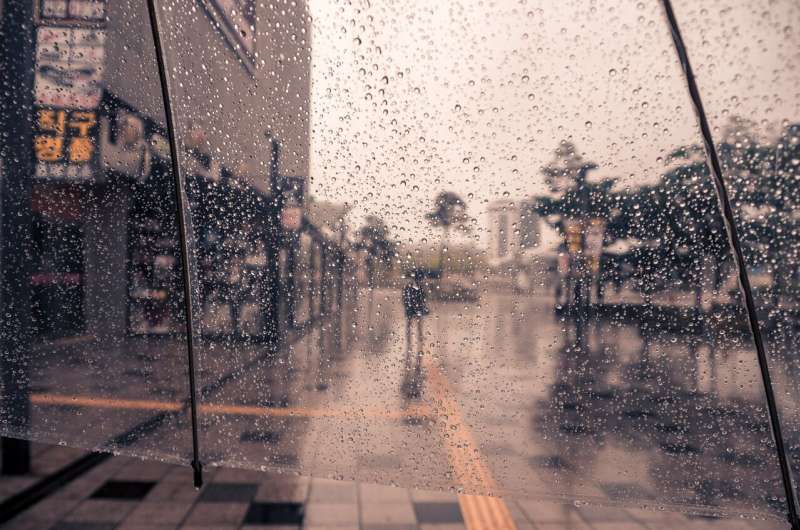Impacts of rainy weather on coronavirus outbreaks reveal economic benefits from earlier social distancing

What can a few rainy days teach us about the economics of combating the coronavirus pandemic? Quite a lot, as it turns out.
The weekend before the first wave of stay-at-home orders were issued, rainy weather prompted behaviors similar to early social distancing in some counties across the U.S., and health data indicate that these behavior changes likely saved lives. Economists at UC Santa Cruz have studied the effects of this stroke of luck as part of a natural experiment. Their findings show how communities that started some form of social distancing slightly earlier may have experienced significant economic benefits.
This new research, published in the Journal of Health Economics, suggests that a 1% decrease in the population leaving home due to rain on the weekend before lockdown likely slowed spread of the virus enough to create an average of up to $132 dollars of benefit per county resident within two weeks, resulting from avoided COVID-19 deaths. Based on these findings, and the results of prior studies, the paper's authors estimate that starting initial pandemic lockdowns two days earlier could have generated as much as $198 to $264 of benefit per person within two weeks, compared to an estimated average cost of $2 to $14 per person in additional lost wages.
"When it comes to implementing lockdowns, I think this shows that having faster decision-making processes really pays off compared to a more wait-and-see approach," said Associate Professor of Economics Ajay Shenoy, lead author of the new paper.
While the public health basis for this argument has long been clear, the paper's findings make an economic case for the merits of quicker action that allows for more direct comparison with some of the economic costs that have driven political debate around stay-at-home orders. And the paper's focus on rain-induced social distancing also provides a unique opportunity to isolate the impacts of social distancing from other related variables.
Shenoy explained that many of the communities in the U.S. that were quickest to implement stay-at-home orders shared common demographic characteristics or similarities in political climate and public health resources. Those factors could impact pandemic outcomes independently, which makes it difficult to hone in on the specific effect of social distancing alone. But rainy weather provided an outside influence that compelled people to stay home across a relatively random sampling of different types of communities.
"It doesn't rain more on a county because it has better hospitals, and the rain doesn't care whether you're rich or poor," Shenoy said, "it just sort of happens randomly—at least after you control for historical weather patterns. So nature handed us a scenario that was pretty well able to simulate a randomized experiment on the impacts of social distancing."
Shenoy says another benefit of natural experiments is that they can prove useful for ground-truthing the predictions of epidemiological models. Ultimately, he hopes the current paper's findings may help to inform public health policy. An analysis within the paper suggests that earlier social distancing at the outset of the pandemic produced economic benefits on average primarily because it lowers the chance of very serious outbreaks in a small number of communities. Shenoy says this illustrates a major political challenge for stay-at-home orders.
"It's hard for leaders in a county to point to a concrete benefit of their policies, because what they've averted is a small chance of a very bad outcome," he said. "The county next door may get lucky and avoid that outcome too, even if they didn't lock down earlier. So you really need to have a very large comparison group to be able to actually detect these types of benefits."
The research team believes their findings may offer a form of large-scale validation for the economic merits of quicker social distancing implementation. In fact, the authors argue that the paper's projected benefits are likely an underestimate, since they focused only on the economic value of lives saved, rather than other potential benefits like reduced health care costs and reduced incidence of chronic illness.
Future research could sharpen the picture by incorporating these additional types of benefits and comparing them alongside other potential costs, like lost business profit, lost schooling time for children, or mental health impacts. More work will also be needed to assess how vaccines, treatments, and more infectious variants may have affected cost-benefit calculations since the first wave of the pandemic.
Still, Shenoy points out that a significant mechanism affecting these calculations is that the costs of earlier social distancing are generally relatively fixed, while the benefits are more likely to continue accruing over time. He hopes that greater understanding of these economic payoffs could bring new perspective to discussions around public health policies.
"In our analysis, the economic benefits overall are really quite large relative to the costs, and the reason for that is somewhat intuitive," he said. "When it comes to slowing the spread of something like the coronavirus, taking steps early to cut off a transmission chain is an investment in public health that's going to pay exponential returns."
More information: Ajay Shenoy et al, God is in the rain: The impact of rainfall-induced early social distancing on COVID-19 outbreaks, Journal of Health Economics (2021). DOI: 10.1016/j.jhealeco.2021.102575



















